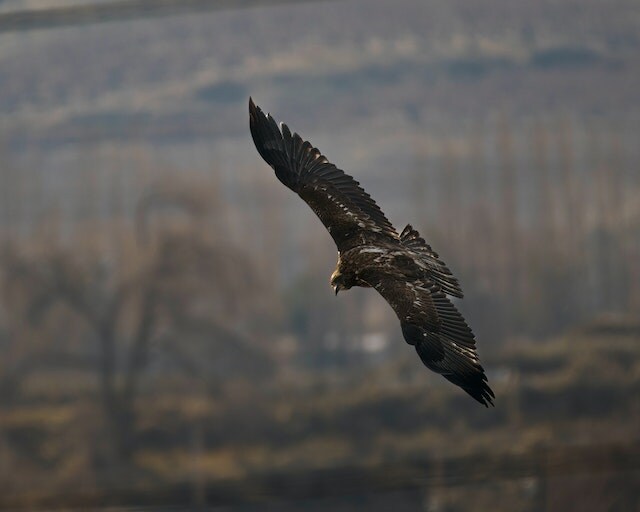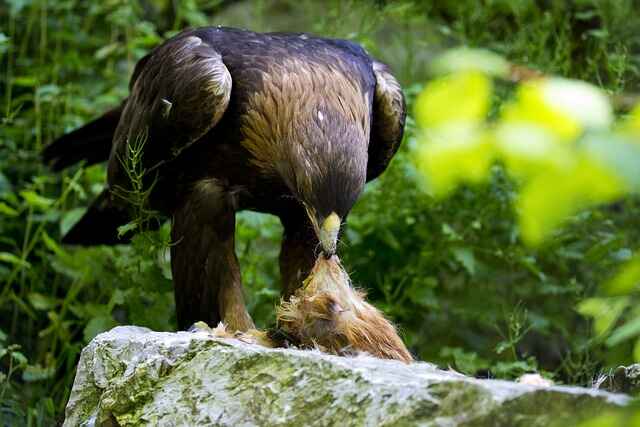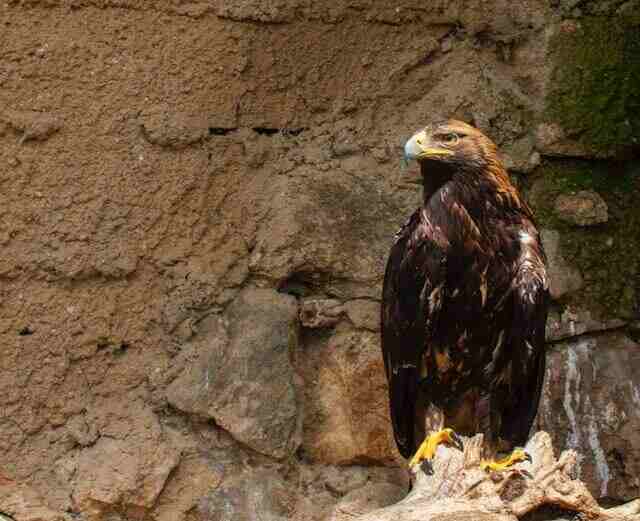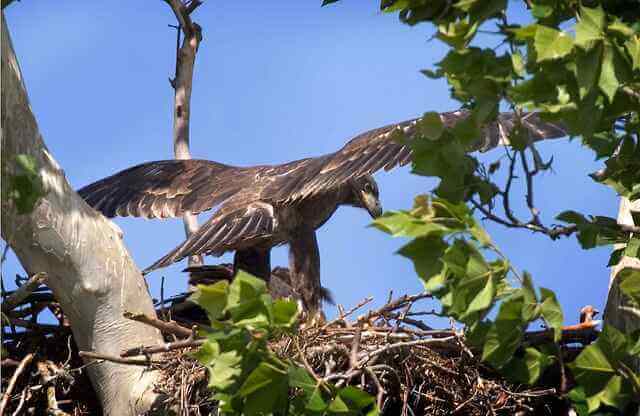Interested in learning some interesting facts about Golden Eagles? Welcome to a fascinating journey into the world of these majestic birds. In this article, we will unveil 60 captivating facts about Golden Eagles, complemented by stunning photos and in-depth insights. If you’re intrigued by the Golden Eagle’s allure, read on!
Table of Contents
- 1 Golden Eagle (Overview)
- 2 Interesting Facts About Golden Eagles
- 2.1 Golden Eagles have a wingspan of up to 7 feet.
- 2.2 Golden Eagles are diurnal birds.
- 2.3 Golden Eagles have a keen sense of hearing.
- 2.4 Golden Eagles have a specialized digestive system.
- 2.5 Golden Eagles are powerful fliers.
- 2.6 Golden Eagles are monogamous and mate for life.
- 2.7 Golden Eagles are opportunistic hunters.
- 2.8 Golden Eagles are long-lived birds.
- 2.9 Golden Eagles have a distinctive call.
- 2.10 Golden Eagles are solitary birds outside of the breeding season.
- 2.11 Golden Eagles have a unique respiratory system.
- 2.12 Golden Eagles are an important part of many ecosystems.
- 2.13 Golden Eagles are threatened by habitat loss and other human activities.
- 2.14 Golden Eagles are protected by law in many countries.
- 2.15 Golden Eagles are a popular subject for wildlife photography.
- 2.16 Golden Eagles are sometimes used in falconry.
- 2.17 Golden Eagles have a high cultural significance in Kazakhstan.
- 2.18 Golden Eagles are sometimes used to control pest populations.
- 2.19 Golden Eagles are sometimes used in research studies.
- 2.20 Golden Eagles have a complex social structure.
- 2.21 Golden Eagles are an important part of Native American culture.
- 2.22 Golden Eagles are sometimes used in rehabilitation programs.
- 2.23 Golden Eagles are an important part of the food chain.
- 2.24 Golden Eagles are highly adaptable birds.
- 2.25 Golden Eagles are sometimes used in wildlife management programs.
- 2.26 Golden Eagles have a unique hunting technique.
- 2.27 Golden Eagles are sometimes used in conservation education programs.
- 2.28 Golden Eagles are an important part of the ecosystem in mountainous regions.
- 2.29 Golden Eagles are sometimes used in airport bird control programs.
- 2.30 Golden Eagles are sometimes used in cultural ceremonies.
- 2.31 Golden Eagles have a unique relationship with prairie dogs.
- 2.32 Golden Eagles are sometimes used in hunting competitions.
- 2.33 Golden Eagles are sometimes used in falconry tourism.
- 2.34 Golden Eagles are sometimes used in wildlife surveys.
- 2.35 Golden Eagles are sometimes used in conservation breeding programs.
- 2.36 Golden Eagles are sometimes used in traditional medicine.
- 2.37 Golden Eagles are sometimes used in art and literature.
- 2.38 Golden Eagles are sometimes used in birdwatching tours.
- 2.39 Golden Eagles have a highly developed sense of sight.
- 2.40 Golden Eagles are sometimes used to control invasive species.
- 2.41 Golden Eagles are sometimes used in bird abatement programs.
- 2.42 Golden Eagles are sometimes used in wildlife conservation programs.
- 2.43 Golden Eagles are sometimes used in search and rescue operations.
- 2.44 Golden Eagles are sometimes used in environmental monitoring programs.
- 2.45 Golden Eagles are sometimes used in scientific studies.
- 2.46 Golden Eagles have a powerful grip.
- 2.47 Golden Eagles are sometimes used in pest bird control programs.
- 2.48 Golden Eagles are sometimes used in cultural festivals.
- 2.49 Golden Eagles are sometimes used in wildlife tourism.
- 2.50 Golden Eagles have a unique hunting strategy.
- 2.51 Golden Eagles are sometimes used in falconry conservation programs.
- 2.52 Golden Eagles are sometimes used in wildlife rehabilitation programs.
- 2.53 Golden Eagles are sometimes used in scientific research on flight behavior.
- 2.54 Golden Eagles are sometimes used in traditional medicine.
- 2.55 Golden Eagles have a unique vocal repertoire.
- 2.56 Golden Eagles are sometimes used in airport wildlife management programs.
- 2.57 Golden Eagles are sometimes used in conservation programs for other species.
- 2.58 Golden Eagles are sometimes used in cultural ceremonies and celebrations.
- 2.59 Golden Eagles are sometimes used in pest control programs for vineyards.
- 2.60 Golden Eagles are sometimes used in wildlife management.
- 3 Author
Golden Eagle (Overview)

| Overview | |
|---|---|
| Identification | Golden Eagles are a very distinctive bird, and not difficult to identify. The Golden Eagle is mostly dark brown with some gray on the inside of the wing and tail, and a golden color on the back of the nape and crown. The bill has a dark tip, fading to a yellow cere. The feet are yellow. They have black eyes that look forward; their head seems small in comparison to their body size because it’s tucked into its shoulders. |
| Length | 28-33.5 in (71-85 cm) |
| Weight | 104-216 oz (6.6-13.5 lbs.) |
| Wingspan | 72.4-87.0 in (184-221 cm) |
| Order | Accipitriformes |
| Family | Accipitridae |
| Genus | Aquila |
| Scientific Name | Aquila Chrysaetos |
| Range | Northern part of North America to Eurasia and Africa in the south. |
| Habitat | Live primarily in mountainous regions, open areas near rivers, lakes or marshes. |
| Diet | Small mammals, rabbits, and hares, but they also eat carrion as well as fish or other birds. |
| Worldwide Population | 120,000 individuals. |
| North America Population | 50,000 individuals. |
| Conservation Status | Listed Least Concern (Population is stable). |
Interesting Facts About Golden Eagles
Golden Eagles have a wingspan of up to 7 feet.
Golden Eagles are large birds of prey with a wingspan of up to 7 feet. Their wings are broad and powerful, allowing them to fly long distances and maneuver quickly. Their wings also have a distinctive shape, with a slight upward curve at the tips.
Golden Eagles are diurnal birds.
Golden Eagles are diurnal birds, meaning that they are active during the day and rest at night. They are most active during the early morning and late afternoon, when they are hunting for prey.
Golden Eagles have a keen sense of hearing.
Golden Eagles have excellent hearing, which allows them to locate prey from a distance. They can detect the sound of small mammals moving through grass or snow, and can even hear the heartbeat of their prey.
Golden Eagles have a specialized digestive system.
Golden Eagles have a specialized digestive system that allows them to extract nutrients from their prey efficiently. They have a muscular gizzard that grinds up bones and other indigestible materials, allowing them to extract every last bit of nutrition from their food.
Golden Eagles are powerful fliers.
Golden Eagles are powerful fliers, able to soar at high altitudes and reach speeds of up to 200 mph. They can also maneuver quickly, making them effective hunters and allowing them to catch prey in flight.

Golden Eagles are monogamous and mate for life.
Golden Eagles form strong pair bonds and remain with their mate for their entire life. They mate in the winter, build a nest together, and both parents participate in incubating the eggs and raising the young.
Golden Eagles are opportunistic hunters.
Golden Eagles primarily eat small mammals such as rabbits and squirrels, but they are opportunistic hunters and will also eat birds, reptiles, and even fish. They are skilled hunters that use a variety of techniques to catch their prey, including aerial attacks, surprise attacks, and chasing prey on foot.
Golden Eagles are long-lived birds.
Golden Eagles can live up to 32 years in the wild, although most do not live beyond 15-20 years. They have a slow reproductive rate, with females typically laying only one or two eggs per year. This means that the survival of their offspring is critical to the long-term survival of the species.
Golden Eagles have a distinctive call.
Golden Eagles have a distinctive call that is often described as a high-pitched scream. They use this call to communicate with each other and establish their territory. The call can be heard from a distance and is a common sound in open and mountainous areas.
Golden Eagles are solitary birds outside of the breeding season.
Golden Eagles are solitary birds outside of the breeding season, although they may form loose groups or pairs during migration. They are known for their aggressive behavior, particularly during the breeding season, and will defend their nests and territories from other birds and potential predators.
Golden Eagles have a unique respiratory system.
Golden Eagles have a unique respiratory system that allows them to extract oxygen more efficiently at high altitudes. They have a larger lung capacity than other birds of the same size, which allows them to fly at high altitudes without becoming fatigued.
Golden Eagles are an important part of many ecosystems.
Golden Eagles play a critical role in many ecosystems as top predators. By controlling the populations of prey species, they help maintain ecological balance and biodiversity. They are also an important indicator of environmental health and can provide valuable insights into the status of the ecosystem.
Golden Eagles are threatened by habitat loss and other human activities.
Golden Eagles face numerous threats from human activities, including habitat loss, collisions with structures, illegal hunting, and climate change. Conservation efforts are underway to mitigate these threats and protect Golden Eagles, including habitat restoration, monitoring and research, and public education and outreach.
Golden Eagles are protected by law in many countries.
Golden Eagles are protected by law in many countries, including the United States, where they are listed under the Migratory Bird Treaty Act. It is illegal to kill, capture, or harm Golden Eagles without a permit, and there are heavy fines and penalties for violating these laws.
Golden Eagles are a popular subject for wildlife photography.
Golden Eagles are a popular subject for wildlife photography, due to their majestic appearance and impressive hunting skills. Photographers often use long lenses and remote cameras to capture images of Golden Eagles in the wild.
Golden Eagles are sometimes used in falconry.
Golden Eagles have been used in falconry for centuries, particularly in Europe and Asia. Falconry is a traditional hunting method that involves using birds of prey to catch small game, such as rabbits and pheasants. Golden Eagles are highly valued for their hunting abilities and are trained to hunt under the guidance of a falconer.
Golden Eagles have a high cultural significance in Kazakhstan.
Golden Eagles have a special cultural significance in Kazakhstan, where they are used in traditional hunting practices known as berkutchi. In berkutchi, Golden Eagles are trained to hunt foxes and other small game, and are highly valued for their hunting abilities. The practice has been passed down through generations and is an important part of Kazakh culture.
Golden Eagles are sometimes used to control pest populations.
Golden Eagles are sometimes used to control pest populations, particularly in agricultural areas. By hunting rodents and other small mammals, Golden Eagles can help reduce the damage caused by pests and improve crop yields. This practice is becoming more popular as an alternative to chemical pesticides.
Golden Eagles are sometimes used in research studies.
Golden Eagles are sometimes used in research studies to better understand their behavior, ecology, and conservation needs. Researchers may attach GPS or radio transmitters to Golden Eagles to track their movements and behavior, or collect blood and tissue samples to study their genetics and health.
Golden Eagles have a complex social structure that includes pair bonds, territorial behavior, and vocalizations. They use a variety of vocalizations to communicate with each other and establish their territory, and are known for their aggressive behavior during the breeding season.
Golden Eagles are an important part of Native American culture.
Golden Eagles have a special cultural significance in many Native American tribes, where they are seen as symbols of strength, courage, and power. They are used in ceremonies and as spiritual guides, and are an important part of Native American mythology and folklore.

Golden Eagles are sometimes used in rehabilitation programs.
Golden Eagles that have been injured or orphaned are sometimes taken in by wildlife rehabilitation centers, where they are nursed back to health and released back into the wild. These programs are important for helping to protect Golden Eagles and other birds of prey from the impacts of human activities.
Golden Eagles are an important part of the food chain.
Golden Eagles play a critical role in the food chain as top predators. By controlling the populations of prey species, they help maintain ecological balance and biodiversity, and prevent overgrazing or overpopulation of certain species. Their presence can also indicate the health of the ecosystem, as they require a diverse range of habitats and prey species to survive.
Golden Eagles are highly adaptable birds.
Golden Eagles are highly adaptable birds that can thrive in a variety of habitats, as long as there is enough prey and suitable nesting sites. They have been known to nest on cliffs, in trees, and even on the ground in some areas.
Golden Eagles are sometimes used in wildlife management programs.
Golden Eagles are sometimes used in wildlife management programs to control populations of nuisance species, such as geese or feral pigs. By hunting these species, Golden Eagles can help reduce the damage they cause to crops or natural habitats.
Golden Eagles have a unique hunting technique.
Golden Eagles have a unique hunting technique that involves using their powerful talons to catch and kill their prey. They may also use their wings to knock their prey off balance or chase them on foot.
Golden Eagles are sometimes used in conservation education programs.
Golden Eagles are sometimes used in conservation education programs to teach people about their importance and the threats they face. These programs may include live bird demonstrations, educational materials, and outreach events.
Golden Eagles are an important part of the ecosystem in mountainous regions.
Golden Eagles are an important part of the ecosystem in mountainous regions, where they hunt and nest in high-altitude habitats. They are also an important indicator of environmental health in these areas and can provide valuable insights into the status of the ecosystem.
Golden Eagles are sometimes used in airport bird control programs.
Golden Eagles are sometimes used in airport bird control programs to scare away birds that can pose a threat to aircraft. By flying over runways and other areas, Golden Eagles can help deter other birds from congregating in these areas.
Golden Eagles are sometimes used in cultural ceremonies.
Golden Eagles are sometimes used in cultural ceremonies, particularly in Central Asia and the Middle East. They may be used in weddings, funerals, and other important events, and are highly valued for their beauty and strength.
Golden Eagles have a unique relationship with prairie dogs.
Golden Eagles have a unique relationship with prairie dogs, which are a common prey species in some areas. Prairie dogs are known for their alarm calls, which can alert other animals in the area to the presence of predators. Golden Eagles have been observed using these alarm calls to locate prairie dogs and other small mammals.
Golden Eagles are sometimes used in hunting competitions.
Golden Eagles are sometimes used in hunting competitions, particularly in Central Asia and the Middle East. In these competitions, Golden Eagles are released to hunt small game, and are judged on their speed, agility, and hunting skills.

Golden Eagles are sometimes used in falconry tourism.
Golden Eagles are sometimes used in falconry tourism, where tourists can watch trained birds of prey hunt small game. This practice is becoming more popular in some areas, particularly in the Middle East and Central Asia.
Golden Eagles are sometimes used in wildlife surveys.
Golden Eagles are sometimes used in wildlife surveys to monitor populations of prey species and other wildlife in an area. Researchers may use telemetry or other tracking methods to locate Golden Eagles and observe their behavior.
Golden Eagles are sometimes used in conservation breeding programs.
Golden Eagles that are injured or orphaned may be taken into captivity and used in conservation breeding programs. These programs are important for maintaining genetic diversity and helping to protect the species from the impacts of human activities.
Golden Eagles are sometimes used in traditional medicine.
Golden Eagles are sometimes used in traditional medicine, particularly in Asia and the Middle East. They may be used in remedies for a variety of ailments, although there is little scientific evidence to support their effectiveness.
Golden Eagles are sometimes used in art and literature.
Golden Eagles are a popular subject in art and literature, due to their majestic appearance and cultural significance. They have been featured in paintings, sculptures, and literature throughout history.
Golden Eagles are sometimes used in birdwatching tours.
Golden Eagles are a popular species for birdwatching tours, particularly in areas where they are commonly found. Tourists may use binoculars or spotting scopes to observe Golden Eagles in their natural habitat.
Golden Eagles have a highly developed sense of sight.
Golden Eagles have a highly developed sense of sight, which allows them to spot prey from a distance. Their eyesight is up to eight times better than that of humans, and they can see in both bright and low light conditions.
Golden Eagles are sometimes used to control invasive species.
Golden Eagles are sometimes used in wildlife management programs to control invasive species, such as European starlings or house sparrows. By hunting these species, Golden Eagles can help reduce their impact on native wildlife and habitats.
Golden Eagles are sometimes used in bird abatement programs.
Golden Eagles are sometimes used in bird abatement programs to deter other birds from nesting or congregating in certain areas. By flying over these areas, Golden Eagles can help scare away other birds and reduce the damage they cause.
Golden Eagles are sometimes used in wildlife conservation programs.
Golden Eagles are sometimes used in wildlife conservation programs to help protect other species. For example, Golden Eagles may be used to control populations of feral cats or other predators that threaten endangered species.
Golden Eagles are sometimes used in search and rescue operations.
Golden Eagles have been used in search and rescue operations to locate missing persons or other objects. Their keen eyesight and ability to fly at high altitudes make them effective search and rescue tools in certain situations.

Golden Eagles are sometimes used in environmental monitoring programs.
Golden Eagles are sometimes used in environmental monitoring programs to track changes in the ecosystem or detect pollution. Researchers may use telemetry or other tracking methods to locate Golden Eagles and observe their behavior in different habitats.
Golden Eagles are sometimes used in scientific studies.
Golden Eagles are sometimes used in scientific studies to better understand their behavior, ecology, and conservation needs. Researchers may use a variety of techniques, such as GPS tracking or blood sampling, to collect data on Golden Eagles and their habitat.
Golden Eagles have a powerful grip.
Golden Eagles have a powerful grip, which allows them to catch and carry prey that is much larger than themselves. Their talons can exert a force of 400 pounds per square inch up to 790 psi, making them one of the strongest birds of prey.
Golden Eagles are sometimes used in pest bird control programs.
Golden Eagles are sometimes used in pest bird control programs to deter birds that can cause damage to buildings or other structures. By flying over these areas, Golden Eagles can help scare away other birds and reduce the damage they cause.
Golden Eagles are sometimes used in cultural festivals.
Golden Eagles are sometimes used in cultural festivals, particularly in Central Asia and the Middle East. They may be featured in traditional dances or other performances, and are highly valued for their cultural significance.
Golden Eagles are sometimes used in wildlife tourism.
Golden Eagles are sometimes used in wildlife tourism, where tourists can watch trained birds of prey hunt small game or perform other behaviors. This practice is becoming more popular in some areas, particularly in Europe and North America.
Golden Eagles have a unique hunting strategy.
Golden Eagles have a unique hunting strategy that involves using their wings to create a shadow that can help them sneak up on prey. This technique is particularly effective in open areas, such as deserts or grasslands.
Golden Eagles are sometimes used in falconry conservation programs.
Golden Eagles are sometimes used in falconry conservation programs to help protect the species from the impacts of human activities. These programs may include captive breeding, habitat restoration, and public education and outreach.
Golden Eagles are sometimes used in wildlife rehabilitation programs.
Golden Eagles that have been injured or orphaned may be taken in by wildlife rehabilitation centers, where they are nursed back to health and released back into the wild. These programs are important for helping to protect Golden Eagles and other birds of prey from the impacts of human activities.
Golden Eagles are sometimes used in scientific research on flight behavior.
Golden Eagles are sometimes used in scientific research on flight behavior, particularly in relation to wind patterns and turbulence. Researchers may use telemetry or other tracking methods to observe Golden Eagles in flight and collect data on their behavior.
Golden Eagles are sometimes used in traditional medicine.
Golden Eagles are sometimes used in traditional medicine, particularly in Asia and the Middle East. They may be used in remedies for a variety of ailments, although there is little scientific evidence to support their effectiveness.
Golden Eagles have a unique vocal repertoire.
Golden Eagles have a unique vocal repertoire that includes a variety of calls and vocalizations. These vocalizations are used for communication between individuals and to establish territory.

Golden Eagles are sometimes used in airport wildlife management programs.
Golden Eagles are sometimes used in airport wildlife management programs to deter birds and other wildlife that can pose a threat to aircraft. By flying over runways and other areas, Golden Eagles can help scare away other birds and reduce the risk of bird strikes.
Golden Eagles are sometimes used in conservation programs for other species.
Golden Eagles are sometimes used in conservation programs for other species, particularly those that are threatened or endangered. For example, Golden Eagles may be used to control populations of feral cats or other predators that threaten endangered birds or mammals.
Golden Eagles are sometimes used in cultural ceremonies and celebrations.
Golden Eagles are sometimes used in cultural ceremonies and celebrations, particularly in Central Asia and the Middle East. They may be featured in traditional dances or other performances, and are highly valued for their cultural significance.
Golden Eagles are sometimes used in pest control programs for vineyards.
Golden Eagles are sometimes used in pest control programs for vineyards, where they can help control populations of birds that feed on grapes. By flying over the vineyards, Golden Eagles can help scare away other birds and reduce the damage they cause.
Golden Eagles are sometimes used in wildlife management.
Golden Eagles are sometimes used in wildlife management programs to control rabbit populations in areas where they are causing damage to crops or natural habitats. By hunting rabbits and other small mammals, Golden Eagles can help reduce their impact on the environment.




